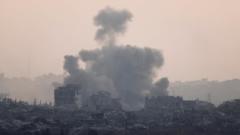Amid mounting pressures, the U.S. has presented Hamas with a cease-fire proposal endorsed by Israel, aimed at facilitating humanitarian aid to Gaza. However, Hamas remains doubtful, highlighting critical gaps in the proposal regarding the guarantees for lasting peace.
Cease-Fire Initiative in Gaza Faces Skepticism from Hamas

Cease-Fire Initiative in Gaza Faces Skepticism from Hamas
The U.S. proposes a cease-fire plan with Israeli backing, but doubts linger regarding its effectiveness in ending hostilities.
In the latest developments surrounding the ongoing conflict in Gaza, the White House has put forward an Israeli-supported cease-fire plan to Hamas, which aims to permit essential humanitarian aid into the region. This proposal comes amidst escalating international demands to halt the continuous violence affecting the area. According to officials from both the U.S. and Israel, this initiative was submitted by President Trump and Middle East envoy Steve Witkoff after Israel’s approval.
The outline and details of the cease-fire include an initial halt to hostilities for 60 days and the subsequent delivery of aid through operations managed by the United Nations. Although the offer has not been outright rejected, Hamas has expressed doubts about its robustness, particularly regarding conditions tied to ending the war.
White House Press Secretary Karoline Leavitt emphasized ongoing discussions and expressed hope for a cease-fire to facilitate the safe return of hostages. Meanwhile, State Department representative Tammy Bruce acknowledged uncertainty about Hamas's acceptance of the offer but noted a shred of optimism regarding the agreement's potential.
Despite these developments, the key sticking points remain unresolved. Israel demands the ability to resume military action if Hamas does not disarm, while Hamas seeks firm assurances that a temporary cease-fire will transition into a permanent halt to fighting, which includes a full withdrawal of Israeli forces from Gaza.
After 18 months of relentless conflict, any cessation of hostilities would come as welcome news to a weary international community, including several of Israel’s allies such as Germany, Italy, and France, who have criticized Israel’s military actions and the civilian toll in Gaza. The diplomatic landscape continues to evolve as stakeholders await Hamas's response to the latest cease-fire proposal.
The outline and details of the cease-fire include an initial halt to hostilities for 60 days and the subsequent delivery of aid through operations managed by the United Nations. Although the offer has not been outright rejected, Hamas has expressed doubts about its robustness, particularly regarding conditions tied to ending the war.
White House Press Secretary Karoline Leavitt emphasized ongoing discussions and expressed hope for a cease-fire to facilitate the safe return of hostages. Meanwhile, State Department representative Tammy Bruce acknowledged uncertainty about Hamas's acceptance of the offer but noted a shred of optimism regarding the agreement's potential.
Despite these developments, the key sticking points remain unresolved. Israel demands the ability to resume military action if Hamas does not disarm, while Hamas seeks firm assurances that a temporary cease-fire will transition into a permanent halt to fighting, which includes a full withdrawal of Israeli forces from Gaza.
After 18 months of relentless conflict, any cessation of hostilities would come as welcome news to a weary international community, including several of Israel’s allies such as Germany, Italy, and France, who have criticized Israel’s military actions and the civilian toll in Gaza. The diplomatic landscape continues to evolve as stakeholders await Hamas's response to the latest cease-fire proposal.






















